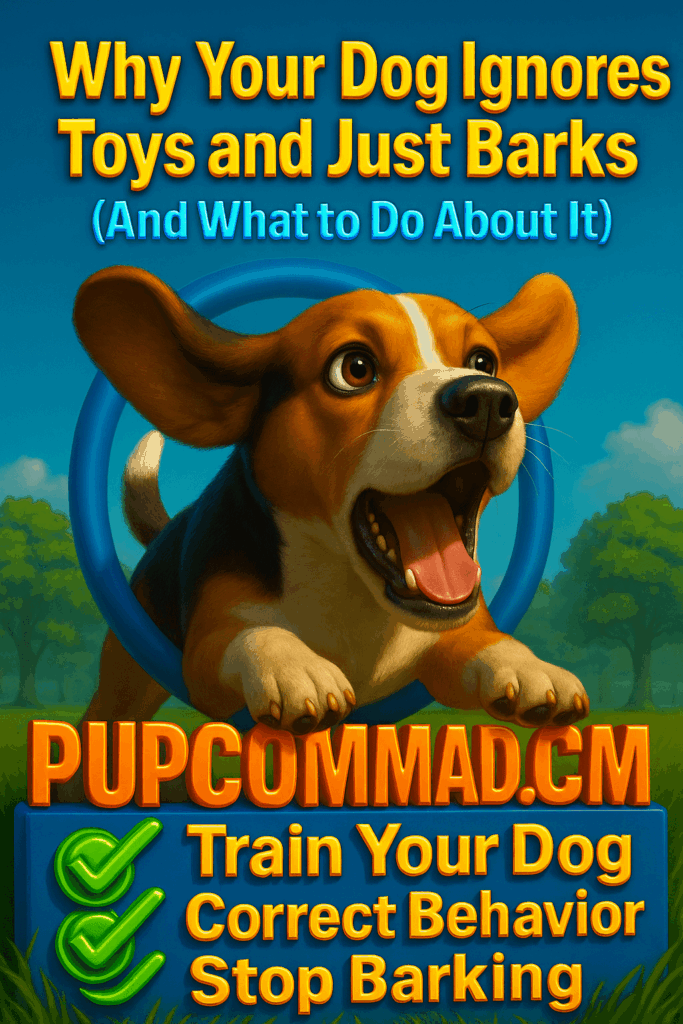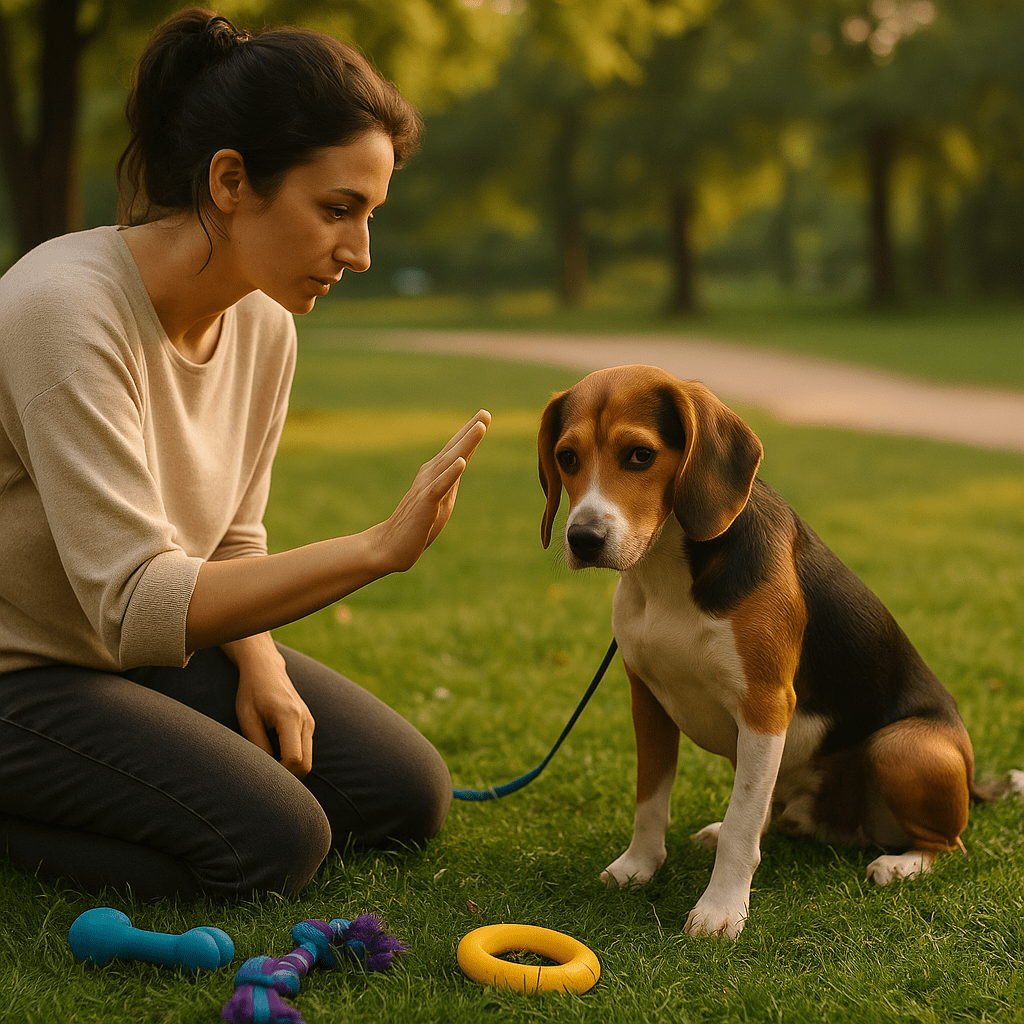
Why Dogs Bark Instead of Playing
Stop dog barking at strangers by understanding why toys get ignored—and how to change that using calm redirection training. Some dogs bark instead of playing with toys due to:
- 📢 Learned Attention-Seeking: Barking = attention, even if it’s negative
- 🧠 Lack of mental enrichment: Toys may not be stimulating enough
- 🐾 High arousal or anxiety: Overstimulation leads to vocal outbursts
- ❌ Poor toy association: Never taught how to play appropriately
If a dog never learned to interact with toys in a rewarding way, they’ll fall back on what worked before—barking.
🦴 Why Dogs Bark Instead of Playing
Some dogs bark at toys because they’re confused, overstimulated, or unsure how to interact with them.
Barking can also be a learned way to get your attention, especially if the toy experience has been inconsistent or overwhelming.
🎯 What This Behavior Really Means
Barking at toys instead of playing is often a sign of unmet needs:
- 🚫 Not enough mental stimulation
- 😣 Pent-up frustration or anxiety
- 🧠 Lack of clear play patterns or reinforcement
🧩 Simple Fixes to Try Right Now
Try these bite-sized solutions:
- ✅ Introduce one toy at a time (remove the toy pile!)
- 🕓 Schedule structured short play sessions (5–10 minutes)
- 🎉 Reinforce toy engagement with praise or treats
- 🐕 Use interactive toys like puzzle feeders or flirt poles to teach purpose
🧘 Calm First, Play Second
Before play, help your dog enter a calm state. A short walk or training exercise can reset their brain.
Once calm, reintroduce the toy. If barking returns, pause and repeat after a few minutes.
Behavior Snapshot
This is happening: Your dog ignores all toys and instead barks excessively for attention, food, or stimulation.
Many owners struggle to stop dog barking at strangers, especially when toys are ignored. So do this: Follow this Bark Redirect Protocol.
🐶 Try the Dogo App – Calm Your Dog with Science →Step 1: Choose the Right Enrichment Toy
- 🧩 Pick a food-dispensing toy (KONG, snuffle mat, puzzle feeder)
- 🍗 Fill it with high-value, soft food (wet food, peanut butter, shredded chicken)
- ❄️ Freeze it if needed to increase challenge and duration
Pro tip: The goal is to make the toy more reinforcing than barking.
Step 2: Interrupt Barking — Offer the Toy Immediately
- 👂 As soon as barking begins, calmly say, “Find it”
- 🧤 Toss the toy in front of your dog without eye contact
- 🕒 Walk away silently for 30–60 seconds to remove your attention
- 🔁 Repeat this every time barking starts
This teaches your dog: Barking gets ignored. Calm behavior earns engagement.
Step 3: Reinforce Quiet Toy Time
- 🐕🦺 Praise your dog quietly if they stay engaged with the toy
- 🎯 Drop bonus treats in the toy randomly while they’re focused
- 📶 Keep your presence calm and neutral to avoid overstimulation
Over time, you’re shaping the habit of choosing toys as a coping tool.
Step 4: Add Play Cues for Real Toys
Once barking fades, build motivation for play:
- 🧸 Use tug or fetch with high-energy verbal cues (“Get it!”, “Let’s go!”)
- 🐾 Play for 20–30 seconds, then pause
- 🎁 If your dog brings the toy back or drops it, reward with more play or a treat
Short sessions build value in the toy without overstimulation.
📦 Crate Training Blueprint: Raise a Calm, Confident Puppy
Struggling with barking, reactivity, or nighttime chaos? The root cause often starts in the home environment. This $7 PDF kit gives you the science-based, emotionally attuned strategy to build calm—one crate session at a time.
👉 Download the Crate Training BlueprintBonus: Preemptive Enrichment
- 🕗 Give your dog a puzzle or sniff walk before attention-seeking windows (e.g., early morning, post-meal)
- 📱 Schedule toy time like a routine (e.g., after breakfast, before bed)
- 🎵 Try background music to lower arousal
What NOT to Do
- ❌ Don’t scold barking—it reinforces attention-seeking
- ❌ Don’t throw random toys and hope it works
- ❌ Don’t chase your dog or yell to get them to stop
All these actions make you part of the barking reinforcement loop.
Tools That Help
- 🍖 Stuffable enrichment toys (KONG, Toppl, etc.)
- 🛏️ Designated play space or mat
- 📦 Treat pouch for rapid reward
- 🧠 Snuffle mats, licky mats, or frozen broths

Case Study: Meet Daisy.
A 3-year-old Beagle mix rescued from a rural shelter, Daisy had never learned how to play. Toys meant nothing to her. People, on the other hand? They meant noise. Barking at strangers had become her language. Every time a visitor knocked, walked past, or even laughed too loud, Daisy would erupt — frantic, defensive, overwhelmed.
Her family tried everything: distraction, yelling, even ignoring her. But nothing worked. The moment she heard footsteps, she’d charge the window, tail stiff, voice hoarse from barking. It wasn’t aggression—it was panic.
Daisy wasn’t being bad. She was begging for help.
The Turning Point
After stumbling onto a gentle training protocol focused on enrichment-based redirection, Daisy’s guardian tried something different.
- Before guests came, Daisy was given a frozen peanut-butter-stuffed snuffle toy.
- Barking was calmly interrupted with a “Find it” cue.
- Every time she chose the toy over the door, she was rewarded—not just with food, but with calm praise and safety.
At first, she barked anyway. But day by day, her nervous energy melted into focus. The toy became her outlet. Eventually, Daisy didn’t just ignore strangers—
she looked forward to them.
The Breakthrough Moment
One evening, Daisy stood quietly near the door as friends arrived.
No lunging.
No barking.
Just her tail wagging softly as she nuzzled her enrichment toy.
Her guardian cried.
It wasn’t just that the barking stopped.
It was that Daisy had finally learned:
She was safe. She had a choice. And she could be heard without shouting.
“I thought she was broken. But she just needed a way to feel confident again.”
— Daisy’s Guardian
Daisy wasn’t being bad. She was begging for help.
🧠 Training Methods Used:
Final Thoughts
Dogs who ignore toys and default to barking aren’t broken—they’re trying to communicate. By rewiring that instinct with structured, rewarding interactions, you teach your dog to calm themselves, play with purpose, and seek connection over chaos.
Start small. Be consistent. Your dog will learn.
